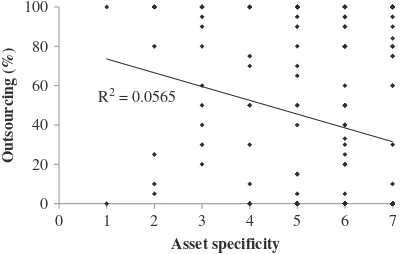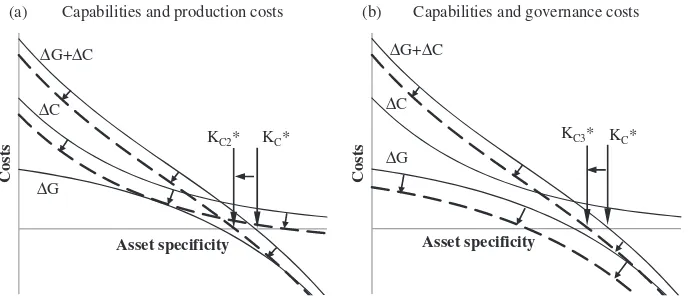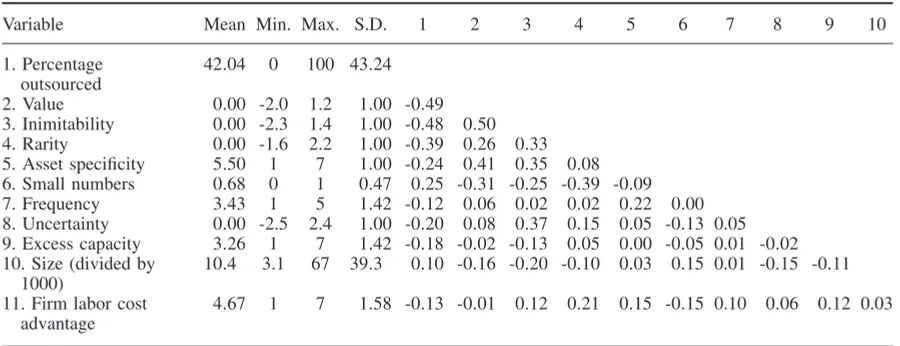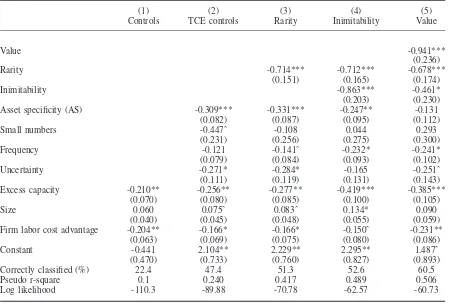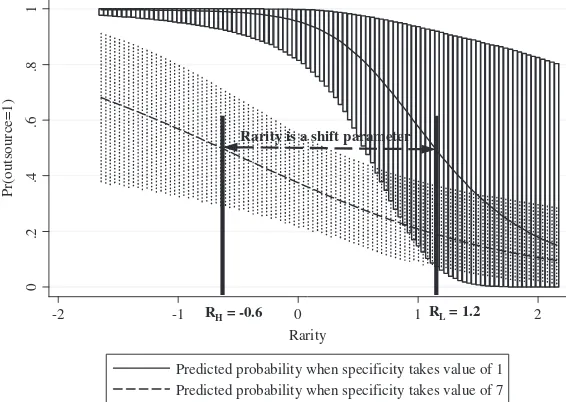Strat. Mgmt. J.,35: 1881–1890 (2014) Published online EarlyView 11 November 2013 in Wiley Online Library (wileyonlinelibrary.com) DOI: 10.1002/smj.2193 Received 16 July 2012;Final revision received 12 September 2013
RESEARCH NOTES AND COMMENTARIES
CAPABILITIES AS SHIFT PARAMETERS
FOR THE OUTSOURCING DECISION
AMIT JAIN1
* and RAYMOND-ALAIN THIETART2
1D-ETM and the Department of Strategy and Policy, National University of Singapore, Singapore
2Department of Management, ESSEC Business School, Cergy Pontoise, France
In this paper, we argue that capabilities serve as shift parameters that result in a change in the critical value of asset specificity at which firms switch from in-sourcing to outsourcing. Capabilities have two effects: they result in a change in firm production costs and in firm governance costs relative to the market. As a result, the frontier at which market governance gives way to firm governance shifts. Three factors that produce such shifts are the value, rarity, and inimitability of capabilities employed in firm processes. Considered as shift parameters, the effect of capabilities integrates seamlessly into transaction costs reasoning and is not a competing view of firm governance. We demonstrate these arguments empirically using a sample of 180 information systems sourcing decisions. Copyright2013 John Wiley & Sons, Ltd.
INTRODUCTION
Transaction cost economics (TCE) has emerged as one of the leading perspectives of firm governance, yet considerable debate remains regarding its empirical support. TCE predicts that the likelihood of the use of market governance decreases monotonically with an increase in asset specificity (Williamson, 1985). Empirical data, however, often posits a weaker and more ambiguous relationship (Carter and Hodgson, 2006; David and Han, 2004). This may arise due to the omission of a number of alternative explanations such as agency, learning (Vanneste and Puranam, 2010), capabilities (Argyres, 1996; Capron and Mitchell, 2009), and knowledge (Jain
Keywords: capabilities; transaction costs; shift parame-ters; make or buy; outsourcing
*Correspondence to: Amit Jain, D-ETM and the Department of Strategy and Policy, National University of Singapore, NUS Business School, Mochtar Riady Building, #6-47 15 Kent Ridge Drive, Singapore 119245. E-mail: [email protected]
Copyright2013 John Wiley & Sons, Ltd.
and Thietart, 2013; Kogut and Zander, 1992). In this research note, we put forward the argument that one reason why TCE offers noisy predictions of governance decisions is that capabilities serve as “shift parameters” that change the critical level of asset specificity at which market governance gives way to hierarchical governance.
Figure 1 illustrates the noisy relationship between outsourcing and asset specificity using our sample of 180 information systems (IS) sourcing decisions. The figure plots the extent to which a firm process is outsourced as a function of asset specificity.1 The figure indicates that (1) in-sourcing occurs even at relatively low values of specificity and (2) outsourcing occurs even at high levels of asset specificity. This is inconsistent with the monotonic relationship that follows from
R2 = 0.0565
Figure 1. Asset specificity and outsourcing
TCE. We propose that one explanation for this noise is that capabilities are omitted variables in TCE analysis that shift the critical value of asset specificity at which market governance transitions to firm governance.
CAPABILITIES AS SHIFT PARAMETERS
Williamson (1991) articulated his shift-parameter framework to describe how changes in institutional environments may result in changes in governance. If the institutional environment is treated as a locus of parameters, comprised for instance of the polit-ical, social, and legal ground rules that establish the basis of production, then changes in these parameters may result in shifts in the comparative costs of governance (Williamson, 1991: 269). For instance, organizations operating in countries that have weak institutional environments will have greater costs of writing and enforcing contracts relative to other organizations operating in strong institutional environments, resulting in a change in the relative cost of hierarchical governance (Nick-erson and Bigelow, 2010). A number of studies provide empirical support for Williamson’s argu-ments, showing that the strength of intellectual property regimes (Oxley, 1999), political and regu-latory institutions (Henisz, 2000), and trust (Gulati and Nickerson, 2008) shift the critical level of asset specificity at which market governance gives way to firm governance.
Gulati and Nickerson’s (2008) study of the role of trust in automotive sourcing decisions has one additional implication: it indicates that Williamson’s shift parameter framework is not limited to the effect of institutions on governance.
Consistent with this, in response to criticism that TCE does not give explicit consideration to the heterogeneity of capabilities across firms, Williamson (1999: 1098) acknowledged that they may serve as “shift parameters” for the sourcing decision.
Capabilities and shifts inproduction costs
According to Williamson (1985), the decision to source an activity results from a comparison of governance costs and costs of production across markets and hierarchies. IfG is the difference in the cost of firm and market governance andC is the difference between firm and market production costs, then outsourcing will occur at all levels of asset specificity below a critical value KC*
at which the sum of governance and production costs is the same for outsourcing and in-sourcing (Figure 2).
Capabilities, we propose, result in a shift in the critical value of asset specificity KC* at which
market governance gives way to hierarchical gov-ernance. Given that capabilities are heterogeneous across firms, the production cost curve is not iden-tical across firms for a focal transaction. If a firm process involves the use of valuable capabilities (relative to the market) that enable it to “implement strategies that improve its efficiency and effec-tiveness” (Barney, 1991: 106), then production becomes more efficient. Lower production costs relative to the market result in adownwards shift of the cost curve (C) for a firm (Figure 2a). As a result, the sum of governance and production costs (G+C) also decreases and the corre-sponding curve shifts downwards and to the left. The consequence for the governance decision is that the critical level of asset specificity at which outsourcing occurs shifts from KC* to KC2*.
Sim-ilarly, rarity also acts as a shift parameter. Rarity indicates that the capabilities required for the exe-cution of a given firm process are unmatched by other rival and partner firms. Given this, a firms’ cost of production is lower than that of the market and the critical level of asset specificity at which in-sourcing takes place “shifts” to a lower value.
(a) Capabilities and production costs
Costs
Asset specificity ∆C
∆G+∆C
∆G
KC* KC2*
(b) Capabilities and governance costs
Costs
Asset specificity ∆C
∆G+∆C
∆G
KC* KC3*
Figure 2. Firm capabilities as shift parameters
in the critical value of asset specificity also endures over time. Inimitability has a second effect. As inimitability increases, firm processes become more difficult to transfer to other firms (Kogut and Zander, 1992), and the cost of using markets increases. Given this, the critical value of asset specificity at which market governance gives way to firm governance shifts to a lower value.
Capabilities and shifts ingovernance costs
Market governance costs are affected by the haz-ard of expropriation of knowledge and capabil-ities (Jain, 2011; Liebeskind, 1996; Mayer and Nickerson, 2005). Consider that a firm has rare and valuable proprietary knowledge and capabil-ities. If transacting involves the transfer of this knowledge and capability to one’s contractual partner, it opens the door to risk of expropria-tion. For instance, the partner firm could use the acquired capabilities for other purposes, such as for other customers or competitors. In these cir-cumstances, contracting will be effective only if the ownership of assets is assigned unambigu-ously by property laws and assets are clearly observable.
When transacting of a process by a firm involves the transfer of rare, valuable and proprietary knowledge and capabilities, then relative to other firms, the firm will be faced with a greater expropriation hazard. This increases costs of market governance to safeguard firm interests, ceteris paribus. As a result, the difference (G) between firm governance and market governance costs decreases, and corresponding to this, the
critical value of asset specificity AS* decreases. Figure 2(b) presents this argument graphically holding production costs fixed. As a result of a lower difference in governance costs (G), the curve representing the difference in firm and market governance costs (G) shifts downward, and the critical value of asset specificity decreases from KC* to KC3*.
The implication of capabilities as shift parame-ters, both through changes in production costs and through changes in governance costs, is that the critical level of asset specificity at which outsourc-ing changes to in-sourcoutsourc-ing decreases. As a result, strong capabilities that result in a decrease in the critical value of asset specificity also decrease the likelihood of a firm using market governance; that is, they decrease the likelihood of outsourcing. The argument that capabilities are shift parameters thus suggests that capability constructs are omit-ted variables in TCE analysis and that the unique analysis of asset specificity and opportunism will have lower predictive power for the outsourcing decision. We summarize these arguments into one hypothesis below:
Hypothesis: The value, rarity, and inimitability of capabilities associated with a firm process serve as shift parameters that decrease the likelihood of outsourcing.
METHODS
Data and constructs
IS processes are particularly interesting for a study of outsourcing as they cover a wide range of activ-ities such as the maintenance of physical assets, software development, the design of enterprise resource planning systems, and the design and upkeep of customer and supplier interphasing soft-ware platforms. Thus, the IS processes that are a part of the sample differ greatly in the level of specific investment required if outsourced, and in the value, rarity, and inimitability of the mobilized underlying capabilities.
In order to test our hypothesis, we gathered data using a survey instrument from July 2006 to August 2007. Senior executives in FTSE100 and CAC40 firms were invited to contribute to the research by (1) identifying at least two firm IS pro-cesses that were in-sourced/outsourced and indi-cating the extent of outsourcing and (2) proposing the names of executives who had experience with the information technology processes. In order to avert the nonindependence of observations, we took care while collecting data to instruct exec-utives not to provide information on related IS processes. We received contact information for 289 executives experienced in outsourcing. Of these, 96 (33.2%) contributed to the study by participat-ing in the survey. After eliminatparticipat-ing observations with missing data, this gave us a total of 180 usable observations.
The different constructs used in analysis were measured using seven-point semantic differential scales. Scales were submitted to factor analysis (Kim and Meuller, 1978) positing a single factor and to the Cronbach’s alpha test of reliability. Only factors with Eigen values greater than 1 were retained. Appendix S2 of the online supplement provides a description of all variables used in our analysis.
Dependent variables
Respondents provided information on the extent to which a given firm IS process had been outsourced, and this ranges from 0 to 100. We transformed this variable to create a binary dependent variable that takes the value of 0 when a process was completely in-sourced, and one when it was partially or completely outsourced. Forty-three percent of the
processes are completely in-sourced and 57 percent are partially or completely outsourced.
Independent variables
Value refers to the value creation potential and the strategic importance of an IS process. It is measured using three items: the extent to which an IS process is considered valuable, the extent to which it permits a firm to differentiate its activities, and the extent to which it is strategically important. These three items load on a unique factor with a reliability ofα=0.78. Second, rarity refers to the uniqueness of a capability relative to other (supplier) firms in the factor market (Barney, 1991). It consists of four items that load onto a unique factor with a reliability of
α=0.77. If, for a given IS process, suppliers in factor markets (relative to the focal firm) do not possess knowledge and skills, equipment and machinery or do not have sufficient productive capacity, then the capabilities related to the IS process are rare. Finally, inimitability provides an indication of the durability of value-creating and rent-seeking advantage. It is operationalized using four items resulting in one factor with a reliability ofα=0.70. IS processes are more inimitable when they draw upon several different technologies, are not easily reverse engineered, are associated with tacit knowledge, and are complex.
Control variables
Seven other variables are controlled for. Four TCE-based effects controlled for include asset specificity, small numbers, transactional fre-quency, and uncertainty. In addition we controlled for excess capacity, firm size, and firm labor cost advantage.
Common method and nonresponse bias
respondents were not informed about what our research question was. Finally, we used Harman’s one-factor test (Podsakoff and Organ, 1986) to check empirically whether common method bias was a problem. It wasn’t as the principal factor accounted for only 21 percent of the variance.
Statistical method
The statistical analysis is comprised of two steps. In the first step, we used a Probit model in order to investigate the influence of the capabil-ities variables on the outsourcing decision. Fol-lowing this, we conducted a number of robust-ness checks including respecifying the dependent variable using different cut-off points for out-sourcing, and as a continuous rather than dichoto-mous and using a Tobit model for analysis. All regressions use clustered standard errors in order to mitigate concerns with respect to the nonin-dependence of observations. Finally, we evalu-ated the magnitude and significance of the coef-ficients of capability constructs on the likelihood of outsourcing.
The Probit model used to assess the effects of the independent variables on outsourcing decision has the general specification as follows:
P(Yi =1|Xi)= (Xiβ) (1)
whereis the cumulative density function for the standard normal;P(Yi=1–Xi) is the probability
that theith IS process is outsourced; andXi is the vector of independent and control variables.
We checked for the robustness of our results taking into consideration the nonlinear nature of limited dependent variable analysis, which includes Probit analysis (Hoetker, 2007; Wiersema and Bowen, 2009; Zelner, 2009). The coefficients obtained in Probit regressions do not represent the true marginal effect of a unit change in an indepen-dent variable as the magnitude and significance of the true marginal effect depends on the values that each other variable takes. As a result, we comple-mented our Probit regressions (Table 2) with addi-tional analysis to interpret the coefficients and the marginal effects appropriately (see Appendix S3 of the online supplement). We used two goodness-of-fit measures: the McFadden pseudo r-square value and the proportion of correctly predicted obser-vations above and beyond those that represent the most frequent outcome (Hoetker, 2007).
RESULTS
Table 1 presents the correlation matrix for the dependent and independent variables, along with the means and standard deviations. Inimitability has a moderate correlation with value (0.50,
p<0.001) and a lower but significant correlation with rarity (0.33, p<0.001). Apart from these correlations, the pattern displayed does not reveal a tendency toward multicollinearity among the independent measures.
Table 1. Descriptive statistics and correlationsa
Variable Mean Min. Max. S.D. 1 2 3 4 5 6 7 8 9 10
1. Percentage outsourced
42.04 0 100 43.24
2. Value 0.00 -2.0 1.2 1.00 -0.49
3. Inimitability 0.00 -2.3 1.4 1.00 -0.48 0.50
4. Rarity 0.00 -1.6 2.2 1.00 -0.39 0.26 0.33
5. Asset specificity 5.50 1 7 1.00 -0.24 0.41 0.35 0.08 6. Small numbers 0.68 0 1 0.47 0.25 -0.31 -0.25 -0.39 -0.09
7. Frequency 3.43 1 5 1.42 -0.12 0.06 0.02 0.02 0.22 0.00
8. Uncertainty 0.00 -2.5 2.4 1.00 -0.20 0.08 0.37 0.15 0.05 -0.13 0.05 9. Excess capacity 3.26 1 7 1.42 -0.18 -0.02 -0.13 0.05 0.00 -0.05 0.01 -0.02 10. Size (divided by
1000)
10.4 3.1 67 39.3 0.10 -0.16 -0.20 -0.10 0.03 0.15 0.01 -0.15 -0.11
11. Firm labor cost advantage
4.67 1 7 1.58 -0.13 -0.01 0.12 0.21 0.15 -0.15 0.10 0.06 0.12 0.03
Table 2. Probit regression with clustered standard errors of the decision to outsource
(1) (2) (3) (4) (5)
Controls TCE controls Rarity Inimitability Value
Value -0.941***
(0.236)
Rarity -0.714*** -0.712*** -0.678***
(0.151) (0.165) (0.174)
Inimitability -0.863*** -0.461*
(0.203) (0.230)
Asset specificity (AS) -0.309*** -0.331*** -0.247** -0.131
(0.082) (0.087) (0.095) (0.112)
Small numbers -0.447ˆ -0.108 0.044 0.293
(0.231) (0.256) (0.275) (0.300)
Frequency -0.121 -0.141ˆ -0.232* -0.241*
(0.079) (0.084) (0.093) (0.102)
Uncertainty -0.271* -0.284* -0.165 -0.251ˆ
(0.111) (0.119) (0.131) (0.143)
Excess capacity -0.210** -0.256** -0.277** -0.419*** -0.385***
(0.070) (0.080) (0.085) (0.100) (0.105)
Size 0.060 0.075ˆ 0.083ˆ 0.134* 0.090
(0.040) (0.045) (0.048) (0.055) (0.059)
Firm labor cost advantage -0.204** -0.166* -0.166* -0.150ˆ -0.231**
(0.063) (0.069) (0.075) (0.080) (0.086)
Constant -0.441 2.104** 2.229** 2.295** 1.487ˆ
(0.470) (0.733) (0.760) (0.827) (0.893)
Correctly classified (%) 22.4 47.4 51.3 52.6 60.5
Pseudo r-square 0.1 0.240 0.417 0.489 0.506
Log likelihood -110.3 -89.88 -70.78 -62.57 -60.73
Standard errors in parentheses, N=180. Regressions are with clustered standard errors. Correct classifications represent predictions above the baseline value. McFadden’s pseudo r-square values are presented.
***p<0.001, **p<0.01, *p<0.05, ˆp<0.1.
The outsourcingdecision
The parameters of the Probit model were estimated using the full sample. Table 2 summarizes the coefficient estimates and goodness-of-fit measures for the models used to test the hypothesis. Since 104 (57%) of the IS processes are partially or completely outsourced (outsourcing = 1), the baseline Probit model with no independent or control variables correctly predicts 57 percent of the cases of the outsourcing decision.
Model (1) is obtained by including only the three non-TCE control variables. In this model the coefficient of excess capacity is negative (p<0.01), indicating as expected that firms with excess capacity have a lower likelihood of out-sourcing. Similarly, the greater the labor costs advantage of a firm relative to suppliers, the lower the likelihood that it will outsource an activ-ity (p<0.01). This model classifies 22.4 percent of the observations correctly above the baseline
prediction of the most frequent outcome.2 Model
(2) adds to model (1) the four transaction cost vari-ables. This model provides support for transaction cost-based influences on the outsourcing decision. As asset specificity increases, firms have a lower likelihood of outsourcing (p<0.001). In addition, uncertainty lowers the likelihood of outsourcing (p<0.05). All in all, the introduction of TCE variables improves the predictive performance of model (1) by an additional 25 percent.
Model (3) introduces the measure for rarity of the capabilities associated with an IS pro-cess. The coefficient of rarity is negative and sig-nificant (β= −0.714, p<0.001), providing sup-port for our hypothesis that capabilities serve
as shift parameters that decrease the likelihood of outsourcing. This model successfully predicts 51.3 percent of the sourcing decisions correctly above and beyond the baseline prediction of the most frequent outcome.
Model (4) introduces the construct inimitability. Inimitability has a significant and negative coef-ficient as expected (β= −0.863, p<0.001). This provides further support for our hypothesis that capabilities serve as shift parameters that lower the likelihood of outsourcing. Rarity remains signifi-cant in the model. Model (5) includes the construct for value. The coefficient of value is significant and negative (β= −0.941,p<0.001), providing addi-tional support for our hypothesis that capabilities serve as shift parameters that lower the likelihood of outsourcing. Further, the capabilities based con-structs of rarity and imitability remain significant indicating that the results are robust. The model correctly predicts 60.5 percent of the observations as in-sourced or outsourced above the baseline pre-diction.
Appendix S3 of the online supplement provides a graphical analysis of the magnitude and signifi-cance of the marginal effects at each observation point for each of the three capability constructs taking into consideration model (5) of Table 2. The analysis indicates that the marginal effect of rarity (Figure S1) and value (Figure S3) is a signif-icant decrease in the likelihood of outsourcing. The marginal effect of inimitability (Figure S2), on the other hand, is negative but does not have a signifi-cant effect at the 5 percent level. Thus, for the case of rarity and value, our marginal effects analysis provides additional support for the hypothesis that capabilities serve as shift parameters that lower the likelihood of outsourcing.
Robustness checks
In Appendix S4 of the online supplement, we present a number of robustness tests. First, our results do not qualitatively change when alterna-tive cutoff points of 25, 50, and 75 percent are used to classify a process as in-sourced or outsourced. Second, our results for capabilities as shift param-eters remain robust when we use a continuous dependent variable (percent of process outsourced) instead of a binary dependent variable. Finally, since our measure of asset specificity is a single-item variable, we checked for robustness of our results using an alternative construct: contractual
hazard, and the results are robust to this new model specification.
Nonindependence of observations
Since each respondent to our survey instrument provided information on two IS processes, our observations may violate the assumption of nonin-dependence of observations. To check whether this represents a problem, we did three additional tests: (1) ordinary least square regressions with clustered standard errors (see Appendix S5 of the online supplement); (2) mean centering; (3) use of only one observation per respondent. These tests indi-cate that the nonindependence of observations is not a major concern.
Illustrating the shiftparameter effect
graphically
To this point, our results provide strong support that capabilities significantly decrease the likeli-hood of outsourcing decisions. Since the proba-bility of outsourcing decreases with increases in capability constructs, the result is a shift in the critical value of asset specificity to a lower value. We now illustrate this argument graphically by showing how the critical value of asset specificity may shift from a high value (AS*=7) to a low value (AS*=1) with a change in capabilities. We provide a 95 percent confidence interval for the predicted probabilities, using Stata code provided by Zelner (2009).
Figure 3 plots the probability of outsourcing as a function of rarity, which is a standardized variable with mean 0. The figure plots the probability of outsourcing using two levels of asset specificity. A number of observations may be made. First, the probability of outsourcing decreases substantially when asset specificity changes from the low value to the high value, and the nonoverlapping confidence intervals provide an indication that this difference is significant over a broad range of rarity values. Second, consistent with the shift parameter logic, the probability of outsourcing decreases with increases in rarity.
0
.2
.4
.6
.8
1
Pr(outsource=1)
-2 -1 0 1 2
Rarity
Predicted probability when specificity takes value of 1 Predicted probability when specificity takes value of 7
RH = -0.6 RL = 1.2
Rarity is a shift parameter
Figure 3. The effect of capabilities on the critical value of asset specificity
critical value of asset specificity? When AS* takes on the higher value of 7, the value of rarity (RH) which results in a predicted probability of
outsourcing of 0.5 is about−0.6. Similarly, when AS* takes on a lower value of 1, the value of rarity (RL), which results in a predicted probability of
outsourcing of 0.5, is about 1.2. What this implies is that, as rarity increases from−0.6 to 1.2, ceteris paribus, the critical level of asset specificity AS* at which outsourcing gives way to in-sourcing shifts (decreases) from 7 to 1.
DISCUSSION AND CONCLUSION
The resource-based view (RBV) emphasizes the role of firm-specific, inimitable resources in creat-ing competitive advantage (Peteraf, 1993; Werner-felt, 1984). Given this, it does not offer any real and discriminating insights into how or why gov-ernance forms need to be aligned with different resource profiles. By introducing capability con-structs as shift parameters into the transaction costs framework, however, our study bridges the gap between value creation and governance and shows that they are interdependent. In other words, while the RBV remains a theory of value creation, it enhances TCE predictions for firm governance.
In order to close the divide between value creation and the governance of transactions, we showed that capabilities serve as shift parameters in the TCE model of firm boundaries. While
Williamson (1985) postulates that there exists a critical level of asset specificity at which market governance gives way to hierarchy, we put forward the argument that this critical value of asset specificity “shifts” due to capability based influences. In particular, strong capabilities result in lower firm production costs relative to the market. Furthermore, since the outsourcing of strong capabilities give rise to expropriation hazard, market governance costs increase relative to firm governance. These two effects together contribute to a decrease in the critical value of asset specificity at which market governance gives way to hierarchy. In other words, if capabilities are not taken into consideration, the unique consideration of TCE would lead to omitted variable bias.
In closing, consistent with Argyres and Zenger’s (2012) argument, we consider capability-based arguments to be complementary to the Williamso-nian TCE framework, not substitutive. Following Williamson (1985), we consider the governance decision as a result of economizing on both gover-nance and production costs. Capability-based con-structs serve to “shift” the critical level of asset specificity at which market governance gives way to hierarchical governance. This, we propose, pro-vides one explanation why numerous empirical studies in TCE in which capabilities are omitted variables show varying results in support of and opposing the TCE framework. Both capability and transaction cost logic, as we showed, complement each other and when separated, can only give a partial picture of firms boundaries’ decisions.
ACKNOWLEDGEMENTS
We would like to thank the National University of Singapore (grant numbers R-535-000-005-133 and R-313-000-090-133) for research funding for this research. We are grateful to senior editor Will Mitchell and two anonymous reviewers for thoughtful and constructive feedback. All remaining errors are our own.
REFERENCES
Argyres NS. 1996. Evidence on the role of firm capabilities in vertical integration decisions.Strategic Management Journal 17(2): 129–150.
Argyres NS, Felin T, Foss N, Zenger T. 2012. Orga-nizational economics of capability and heterogeneity.
Organization Science23(5): 1213–1226.
Argyres NS, Zenger TR. 2012. Capabilities, Transaction Costs, and Firm Boundaries. Organization Science
23(6): 1643–1657.
Barney J. 1991. Firm resources and sustained competitive advantage.Journal of Management 17(1): 99–120. Capron L, Mitchell W. 2009. Selection capability: how
capability gaps and internal social frictions affect internal and external strategic renewal.Organization Science20(2): 294–312.
Carter R, Hodgson GM. 2006. The impact of empirical tests of transaction cost economics on the debate on the nature of the firm.Strategic Management Journal
27(5): 461–476.
David RJ, Han SK. 2004. A systematic assessment of the empirical support for transaction cost economics.
Strategic Management Journal 25(1): 39– 58. Gulati R, Nickerson JA. 2008. Interorganizational trust,
governance choice, and exchange performance. Orga-nization Science19(5): 688– 708.
Hamilton BH, Nickerson JA. 2003. Correcting for endo-geneity in strategic management research. Strategic Organization 1(1): 51– 78.
Heckman JJ. 1979. Sample selection bias as a specifica-tion error.Econometrica 47(1): 153–161.
Henisz WJ. 2000. The institutional environment for multinational investment.Journal of Law, Economics & Organization 16(2): 334–364.
Hoetker G. 2007. The use of logit and probit models in strategic management research: critical issues.
Strategic Management Journal 28(4): 331– 343. Jain A. 2011. Connaissance, ressources, concurrence et
les fronti`eres de l’entreprise. Th`ese pour l’obtention du titre de docteur en sciences de gestion `a l’Universit´e de Paris: Dauphine, France.
Jain A, Thietart R-A. 2013. Knowledge based transac-tions and decision framing in information technology outsourcing.Journal of Strategic Information Systems
(Forthcoming)
Kim J, Meuller CW. 1978. Factor analysis statistical methods and practical issues. Sage University Paper Series on Qualitative Applications in The Social Sciences.
Kogut B, Zander U. 1992. Knowledge of the firm, combi-native capabilities, and the replication of technology.
Organization Science (3, Focused Issue: Management of Technology)3: 383–397.
Liebeskind JP. 1996. Knowledge, strategy, and the theory of the firm. Strategic Management Journal (Special Issue: Knowledge and the Firm)17: 93–107. Mayer KJ, Nickerson JA. 2005. Antecedents and
per-formance implications of contracting for knowledge workers: evidence from information technology ser-vices.Organization Science16(3): 225–242. Nickerson J, Bigelow L. 2010. New institutional
eco-nomics, organization, and strategy. In New Insti-tutional Economics. A Guidebook, Brousseau E, Glachant J-M (eds). Cambridge University Press: New York; 183–208.
Oxley JE. 1999. Institutional environment and the mech-anisms of governance: the impact of intellectual prop-erty protection on the structure of inter-firm alliances.
Journal of Economic Behavior and Organization 38: 283–309.
Peteraf MA. 1993. The cornerstones of competitive advantage: a resource-based view.Strategic Manage-ment Journal 14(3): 179–191.
Podsakoff PM, Organ DW. 1986. Self-reports in organi-zational research: problems and prospects.Journal of Management 12(4): 531–544.
Shaver JM. 1998. Accounting for endogeneity when assessing strategy performance: does entry mode choice affect FDI survival? Management Science
44(4): 571–585.
Vanneste BS, Puranam P. 2010. Repeated interactions and contractual detail: identifying the learning effect.
Organization Science21(1): 186–201.
Wernerfelt B. 1984. A resource-based view of the firm.
Strategic Management Journal 5(2): 171– 180. Wiersema MF, Bowen HP. 2009. The use of limited
issues and methods. Strategic Management Journal
30(6): 679–692.
Williamson OE. 1985. The Economic Institutions of Capitalism (1987 Paperback ed.). New York: Free Press
Williamson OE. 1991. Comparative economic orga-nization: the analysis of discrete structural alter-natives. Administrative Science Quarterly 36(2): 269–296.
Williamson OE. 1999. Strategy research: governance and competence perspectives. Strategic Management Journal 20(12): 1087– 1108.
Zelner BA. 2009. Using simulation to interpret results from logit, probit, and other nonlinear models. Strate-gic Management Journal 30(12): 1335– 1348.
SUPPORTING INFORMATION
Additional supportinginformation maybe found in the online version of this article:
Appendix S1: Capabilities and shifts in critical values of asset specificity.
Appendix S2:Variables, measures, and coefficient alphas.
Appendix S3: Marginal effects of capabilities on outsourcing.
Appendix S4:Robustness checks.
